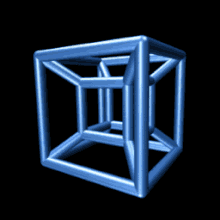Hypercube
In geometry, a hypercube is an n-dimensional analogue of a square (n = 2) and a cube (n = 3). It is a closed, compact, convex figure whose 1-skeleton consists of groups of opposite parallel line segments aligned in each of the space's dimensions, perpendicular to each other and of the same length. A unit hypercube's longest diagonal in n dimensions is equal to .
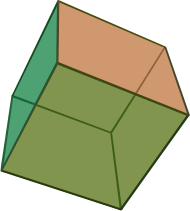 |
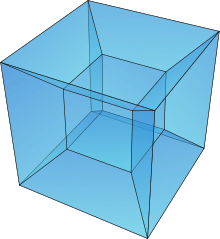 |
| Cube (3-cube) | Tesseract (4-cube) |
|---|
An n-dimensional hypercube is more commonly referred to as an n-cube or sometimes as an n-dimensional cube. The term measure polytope (originally from Elte, 1912)[1] is also used, notably in the work of H. S. M. Coxeter who also labels the hypercubes the γn polytopes.[2]
The hypercube is the special case of a hyperrectangle (also called an n-orthotope).
A unit hypercube is a hypercube whose side has length one unit. Often, the hypercube whose corners (or vertices) are the 2n points in Rn with each coordinate equal to 0 or 1 is called the unit hypercube.
Construction
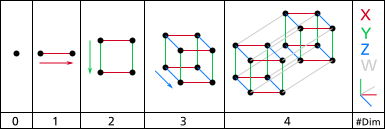
.gif)
A hypercube can be defined by increasing the numbers of dimensions of a shape:
- 0 – A point is a hypercube of dimension zero.
- 1 – If one moves this point one unit length, it will sweep out a line segment, which is a unit hypercube of dimension one.
- 2 – If one moves this line segment its length in a perpendicular direction from itself; it sweeps out a 2-dimensional square.
- 3 – If one moves the square one unit length in the direction perpendicular to the plane it lies on, it will generate a 3-dimensional cube.
- 4 – If one moves the cube one unit length into the fourth dimension, it generates a 4-dimensional unit hypercube (a unit tesseract).
This can be generalized to any number of dimensions. This process of sweeping out volumes can be formalized mathematically as a Minkowski sum: the d-dimensional hypercube is the Minkowski sum of d mutually perpendicular unit-length line segments, and is therefore an example of a zonotope.
The 1-skeleton of a hypercube is a hypercube graph.
Coordinates
A unit hypercube of n dimensions is the convex hull of the points given by all sign permutations of the Cartesian coordinates . It has an edge length of 1 and an n-dimensional volume of 1.
An n-dimensional hypercube is also often regarded as the convex hull of all sign permutations of the coordinates . This form is often chosen due to ease of writing out the coordinates. Its edge length is 2, and its n-dimensional volume is 2n.
Elements
Every n-cube of n > 0 is composed of elements, or n-cubes of a lower dimension, on the (n−1)-dimensional surface on the parent hypercube. A side is any element of (n−1)-dimension of the parent hypercube. A hypercube of dimension n has 2n sides (a 1-dimensional line has 2 endpoints; a 2-dimensional square has 4 sides or edges; a 3-dimensional cube has 6 2-dimensional faces; a 4-dimensional tesseract has 8 cells). The number of vertices (points) of a hypercube is (a cube has vertices, for instance).
The number of m-dimensional hypercubes (just referred to as m-cube from here on) on the boundary of an n-cube is
For example, the boundary of a 4-cube (n=4) contains 8 cubes (3-cubes), 24 squares (2-cubes), 32 lines (1-cubes) and 16 vertices (0-cubes).
This identity can be proved by combinatorial arguments; each of the vertices defines a vertex in a m-dimensional boundary. There are ways of choosing which lines ("sides") that defines the subspace that the boundary is in. But, each side is counted times since it has that many vertices, we need to divide by this number.
This identity can also be used to generate the formula for the n-dimensional cube surface area. The surface area of a hypercube is: .
These numbers can also be generated by the linear recurrence relation
- , with , and undefined elements (where , , or ) .
For example, extending a square via its 4 vertices adds one extra line (edge) per vertex, and also adds the final second square, to form a cube, giving = 12 lines in total.
| m | 0 | 1 | 2 | 3 | 4 | 5 | 6 | 7 | 8 | 9 | 10 | |||
|---|---|---|---|---|---|---|---|---|---|---|---|---|---|---|
| n | n-cube | Names | Schläfli Coxeter |
Vertex 0-face | Edge 1-face | Face 2-face | Cell 3-face | 4-face | 5-face | 6-face | 7-face | 8-face | 9-face | 10-face |
| 0 | 0-cube | Point Monon |
( ) |
1 | ||||||||||
| 1 | 1-cube | Line segment Dion[4] |
{} |
2 | 1 | |||||||||
| 2 | 2-cube | Square Tetragon |
{4} |
4 | 4 | 1 | ||||||||
| 3 | 3-cube | Cube Hexahedron |
{4,3} |
8 | 12 | 6 | 1 | |||||||
| 4 | 4-cube | Tesseract Octachoron |
{4,3,3} |
16 | 32 | 24 | 8 | 1 | ||||||
| 5 | 5-cube | Penteract Deca-5-tope |
{4,3,3,3} |
32 | 80 | 80 | 40 | 10 | 1 | |||||
| 6 | 6-cube | Hexeract Dodeca-6-tope |
{4,3,3,3,3} |
64 | 192 | 240 | 160 | 60 | 12 | 1 | ||||
| 7 | 7-cube | Hepteract Tetradeca-7-tope |
{4,3,3,3,3,3} |
128 | 448 | 672 | 560 | 280 | 84 | 14 | 1 | |||
| 8 | 8-cube | Octeract Hexadeca-8-tope |
{4,3,3,3,3,3,3} |
256 | 1024 | 1792 | 1792 | 1120 | 448 | 112 | 16 | 1 | ||
| 9 | 9-cube | Enneract Octadeca-9-tope |
{4,3,3,3,3,3,3,3} |
512 | 2304 | 4608 | 5376 | 4032 | 2016 | 672 | 144 | 18 | 1 | |
| 10 | 10-cube | Dekeract Icosa-10-tope |
{4,3,3,3,3,3,3,3,3} |
1024 | 5120 | 11520 | 15360 | 13440 | 8064 | 3360 | 960 | 180 | 20 | 1 |
Graphs
An n-cube can be projected inside a regular 2n-gonal polygon by a skew orthogonal projection, shown here from the line segment to the 15-cube.
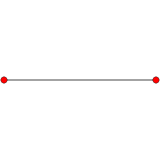 Line segment |
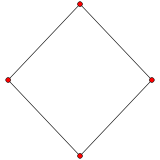 Square |
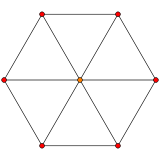 Cube |
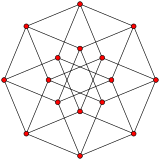 Tesseract |
 5-cube |
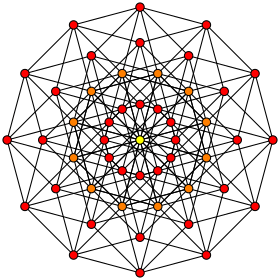 6-cube |
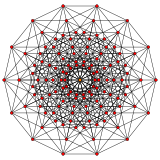 7-cube |
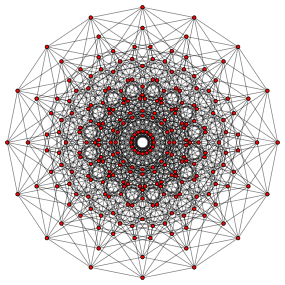 8-cube |
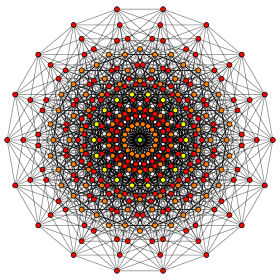 9-cube |
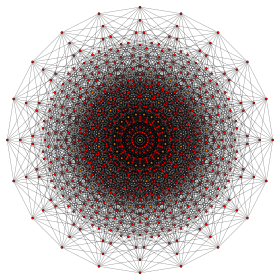 10-cube |
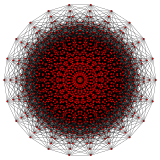 11-cube |
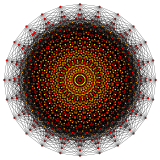 12-cube |
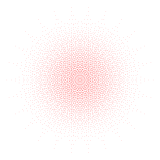 13-cube |
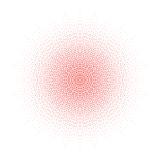 14-cube |
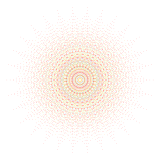 15-cube |
Related families of polytopes
The hypercubes are one of the few families of regular polytopes that are represented in any number of dimensions.
The hypercube (offset) family is one of three regular polytope families, labeled by Coxeter as γn. The other two are the hypercube dual family, the cross-polytopes, labeled as βn, and the simplices, labeled as αn. A fourth family, the infinite tessellations of hypercubes, he labeled as δn.
Another related family of semiregular and uniform polytopes is the demihypercubes, which are constructed from hypercubes with alternate vertices deleted and simplex facets added in the gaps, labeled as hγn.
n-cubes can be combined with their duals (the cross-polytopes) to form compound polytopes:
- In two dimensions, we obtain the octagrammic star figure {8/2},
- In three dimensions we obtain the compound of cube and octahedron,
- In four dimensions we obtain the compound of tesseract and 16-cell.
Relation to (n−1)-simplices
The graph of the n-hypercube's edges is isomorphic to the Hasse diagram of the (n−1)-simplex's face lattice. This can be seen by orienting the n-hypercube so that two opposite vertices lie vertically, corresponding to the (n-1)-simplex itself and the null polytope, respectively. Each vertex connected to the top vertex then uniquely maps to one of the (n-1)-simplex's facets (n-2 faces), and each vertex connected to those vertices maps to one of the simplex's n-3 faces, and so forth, and the vertices connected to the bottom vertex map to the simplex's vertices.
This relation may be used to generate the face lattice of an (n-1)-simplex efficiently, since face lattice enumeration algorithms applicable to general polytopes are more computationally expensive.
Generalized hypercubes
Regular complex polytopes can be defined in complex Hilbert space called generalized hypercubes, γp
n = p{4}2{3}...2{3}2, or ![]()
![]()
![]()
![]()
![]()
![]()
![]()
![]()
n = γn = 2{4}2{3}...2{3}2 = {4,3,..,3}. For p>2, they exist in . The facets are generalized (n-1)-cube and the vertex figure are regular simplexes.
The regular polygon perimeter seen in these orthogonal projections is called a petrie polygon. The generalized squares (n=2) are shown with edges outlined as red and blue alternating color p-edges, while the higher n-cubes are drawn with black outlined p-edges.
The number of m-face elements in a p-generalized n-cube are: . This is pn vertices and pn facets.[5]
| p=2 | p=3 | p=4 | p=5 | p=6 | p=7 | p=8 | ||
|---|---|---|---|---|---|---|---|---|
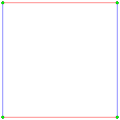 γ2 2 = {4} = 4 vertices |
 γ3 2 = 9 vertices |
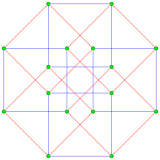 γ4 2 = 16 vertices |
 γ5 2 = 25 vertices |
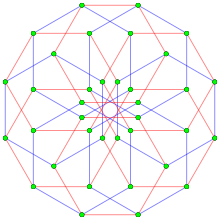 γ6 2 = 36 vertices |
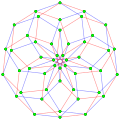 γ7 2 = 49 vertices |
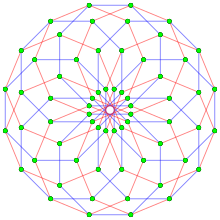 γ8 2 = 64 vertices | ||
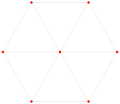 γ2 3 = {4,3} = 8 vertices |
 γ3 3 = 27 vertices |
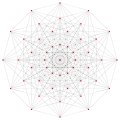 γ4 3 = 64 vertices |
 γ5 3 = 125 vertices |
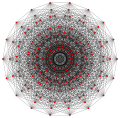 γ6 3 = 216 vertices |
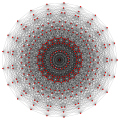 γ7 3 = 343 vertices |
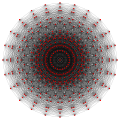 γ8 3 = 512 vertices | ||
 γ2 4 = {4,3,3} = 16 vertices |
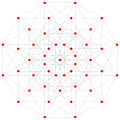 γ3 4 = 81 vertices |
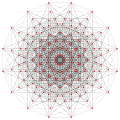 γ4 4 = 256 vertices |
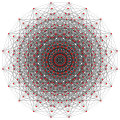 γ5 4 = 625 vertices |
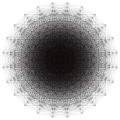 γ6 4 = 1296 vertices |
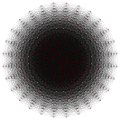 γ7 4 = 2401 vertices |
 γ8 4 = 4096 vertices | ||
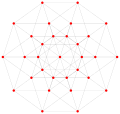 γ2 5 = {4,3,3,3} = 32 vertices |
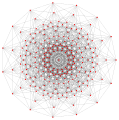 γ3 5 = 243 vertices |
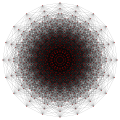 γ4 5 = 1024 vertices |
 γ5 5 = 3125 vertices |
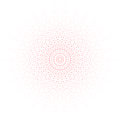 γ6 5 = 7776 vertices |
γ7 5 = 16,807 vertices |
γ8 5 = 32,768 vertices | ||
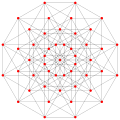 γ2 6 = {4,3,3,3,3} = 64 vertices |
 γ3 6 = 729 vertices |
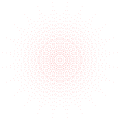 γ4 6 = 4096 vertices |
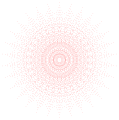 γ5 6 = 15,625 vertices |
γ6 6 = 46,656 vertices |
γ7 6 = 117,649 vertices |
γ8 6 = 262,144 vertices | ||
 γ2 7 = {4,3,3,3,3,3} = 128 vertices |
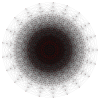 γ3 7 = 2187 vertices |
γ4 7 = 16,384 vertices |
γ5 7 = 78,125 vertices |
γ6 7 = 279,936 vertices |
γ7 7 = 823,543 vertices |
γ8 7 = 2,097,152 vertices | ||
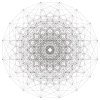 γ2 8 = {4,3,3,3,3,3,3} = 256 vertices |
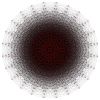 γ3 8 = 6561 vertices |
γ4 8 = 65,536 vertices |
γ5 8 = 390,625 vertices |
γ6 8 = 1,679,616 vertices |
γ7 8 = 5,764,801 vertices |
γ8 8 = 16,777,216 vertices |
See also
- Hypercube interconnection network of computer architecture
- Hyperoctahedral group, the symmetry group of the hypercube
- Hypersphere
- Simplex
- Crucifixion (Corpus Hypercubus) (famous artwork)
Notes
- Elte, E. L. (1912). "IV, Five dimensional semiregular polytope". The Semiregular Polytopes of the Hyperspaces. Netherlands: University of Groningen. ISBN 141817968X.
- Coxeter 1973, pp. 122-123, §7.2 see illustration Fig 7.2C.
- Coxeter 1973, p. 122, §7·25.
- Johnson, Norman W.; Geometries and Transformations, Cambridge University Press, 2018, p.224.
- Coxeter, H. S. M. (1974), Regular complex polytopes, London & New York: Cambridge University Press, p. 180, MR 0370328.
References
- Bowen, J. P. (April 1982). "Hypercube". Practical Computing. 5 (4): 97–99. Archived from the original on 2008-06-30. Retrieved June 30, 2008.
- Coxeter, H. S. M. (1973). Regular Polytopes (3rd ed.). §7.2. see illustration Fig. 7-2C: Dover. pp. 122-123. ISBN 0-486-61480-8.CS1 maint: location (link) CS1 maint: ref=harv (link) p. 296, Table I (iii): Regular Polytopes, three regular polytopes in n dimensions (n ≥ 5)
- Hill, Frederick J.; Gerald R. Peterson (1974). Introduction to Switching Theory and Logical Design: Second Edition. New York: John Wiley & Sons. ISBN 0-471-39882-9. Cf Chapter 7.1 "Cubical Representation of Boolean Functions" wherein the notion of "hypercube" is introduced as a means of demonstrating a distance-1 code (Gray code) as the vertices of a hypercube, and then the hypercube with its vertices so labelled is squashed into two dimensions to form either a Veitch diagram or Karnaugh map.
External links
| Wikimedia Commons has media related to Hypercubes. |
- Weisstein, Eric W. "Hypercube". MathWorld.
- Weisstein, Eric W. "Hypercube graphs". MathWorld.
- www.4d-screen.de (Rotation of 4D – 7D-Cube)
- Rotating a Hypercube by Enrique Zeleny, Wolfram Demonstrations Project.
- Stereoscopic Animated Hypercube
- Rudy Rucker and Farideh Dormishian's Hypercube Downloads
Fundamental convex regular and uniform polytopes in dimensions 2–10 | ||||||||||||
|---|---|---|---|---|---|---|---|---|---|---|---|---|
| Family | An | Bn | I2(p) / Dn | E6 / E7 / E8 / F4 / G2 | Hn | |||||||
| Regular polygon | Triangle | Square | p-gon | Hexagon | Pentagon | |||||||
| Uniform polyhedron | Tetrahedron | Octahedron • Cube | Demicube | Dodecahedron • Icosahedron | ||||||||
| Uniform 4-polytope | 5-cell | 16-cell • Tesseract | Demitesseract | 24-cell | 120-cell • 600-cell | |||||||
| Uniform 5-polytope | 5-simplex | 5-orthoplex • 5-cube | 5-demicube | |||||||||
| Uniform 6-polytope | 6-simplex | 6-orthoplex • 6-cube | 6-demicube | 122 • 221 | ||||||||
| Uniform 7-polytope | 7-simplex | 7-orthoplex • 7-cube | 7-demicube | 132 • 231 • 321 | ||||||||
| Uniform 8-polytope | 8-simplex | 8-orthoplex • 8-cube | 8-demicube | 142 • 241 • 421 | ||||||||
| Uniform 9-polytope | 9-simplex | 9-orthoplex • 9-cube | 9-demicube | |||||||||
| Uniform 10-polytope | 10-simplex | 10-orthoplex • 10-cube | 10-demicube | |||||||||
| Uniform n-polytope | n-simplex | n-orthoplex • n-cube | n-demicube | 1k2 • 2k1 • k21 | n-pentagonal polytope | |||||||
| Topics: Polytope families • Regular polytope • List of regular polytopes and compounds | ||||||||||||

